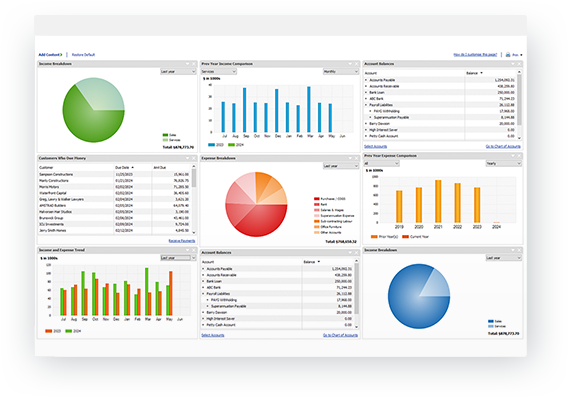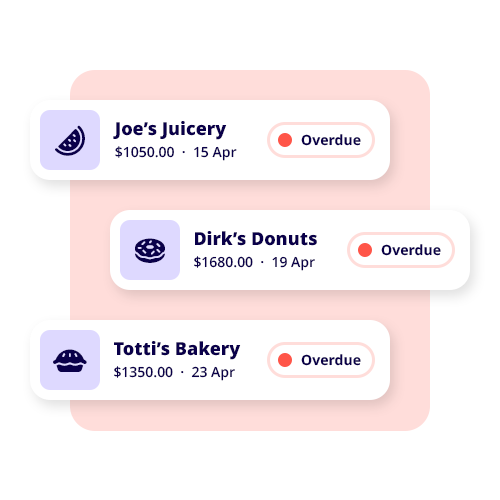Reckon Accounts
Accounting
All the basics to help you manage your cash flow, expenses, invoicing and inventory.

Track cash flow & get paid faster
Manage cash flow by keeping track of sales, payments and directly importing your transactions into Reckon Accounts. Set-up customised invoices and see at a glance what’s been sent, paid and overdue. You can also process credit card payments in Reckon Accounts and look up transactions and billing information for your customers.


Manage GST, prepare your BAS and create impressive reports
Reckon Accounts allows you to track your GST and prepare your BAS. Pre-built reports with drill down functionality including balance sheet, profit and loss and tax liabilities mean you’ll have all the documentation ready to go for tax time.
Plus, with over 100+ types of reports & graphs you can get valuable business insights and your financial position at a glance.
Take control of your stock & inventory management
Reckon Accounts lets you record, track and reconcile everything you buy and sell. Identify what items make you the most money and which items don’t. Quickly view your stock levels and even see what’s on order and when you can expect it.

Pricing
RECKON ACCOUNTS ACCOUNTING
$675 annually
1 user licence supported
Compatible with Windows® 10 & Microsoft® Office 2019
Prepare BAS
Pay bills & track expenses
Track GST & create reports
Customised invoicing
Import & reconcile bank transactions*
Process credit card payments †
Microsoft Office integration
Track and manage inventory
100+ customisable financial reports
ABN Validation
You can also request a free trial here
*Requires internet connection. Available directly from your bank or via Yodlee. Charges apply. Statements can also be imported manually at no cost, check with your financial institution to see if they support this feature.
†Additional fees and charges may apply. An Internet Merchant account is required – contact your financial institution. Subject to PayPal’s approval and accepting their terms and conditions. The availability of the PayPal services is subject to an arrangement with Reckon Ltd and PayPal Pte Ltd (PayPal). If this arrangement is discontinued for any reason these services may no longer be available.
Frequently asked questions
What are the system requirements?
- 2.0 GHz Intel® Pentium® IV (or equivalent)
- At least 512MB of RAM for a single user and at least 1GB of RAM for multiple, concurrent users
- 1GB of RAM for Windows® 8 and 10 users (Windows 8 & 10 require 1GB for 32-bit & 2GB for 64-bit)
- 1GB RAM for Windows Server 2012/2016/2019/2022*
- Windows 8/10/11 operating system
- 1 GB of disk space (additional space required for company files)
- Microsoft® Internet Explorer 11.0 or later required
- Microsoft® .NET Framework Common Language
- Runtime 2.0 & 3.5 (provided with the downloaded Reckon Accounts Installation, requires an additional 150MB)
- (New Zealand only) Microsoft® .NET Framework 4.0 for the Reckon NZ Payroll E-File Checker (provided on the downloaded Reckon Accounts Setup file, requires an additional 150 MB)
- Requires 9 MB for Pro Timer
- At least 256-colour SVGA video
- 1024x768 pixel screen resolution
- All online features and services require Internet access with at least a 56 Kbps modem (ADSL or Cable Modem recommended)
Integration/compatibility requirements
- Microsoft®Word, Excel and Outlook integration require Microsoft Word, Excel and Outlook 2013, 2016, 2019, or 2021.
- Compatible with Reckon Point of Sale Professional v22 or Lite v22.
Multi-user requirements
- Multi-user mode is optimised for Windows Server 2012, Windows Server 2016, Windows Server 2019, Windows Server 2022 operating systems, and for Windows 8.1, Windows 10**, and Windows 11.
- Terminal Services are supported for Reckon Accounts Premier and Enterprise.
How will I receive my software?
I want to convert from another product to Reckon
Please visit our data conversion page for more information.
Is Reckon Accounts available in a Full version licence?
“Reckon is the best accounting programme I have used, and your support is 10 out of 10. I have been a bookkeeper for 30+ years.”
Barbara Brabiner, Whale Cove
